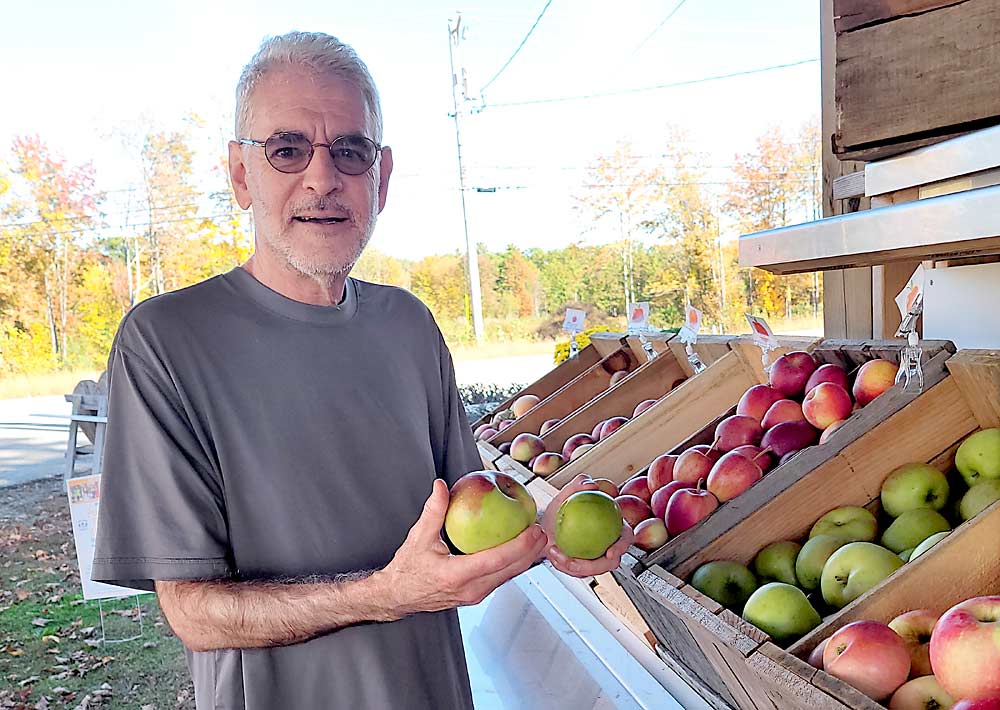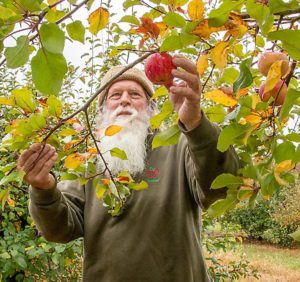
Adam Auster finds Honeycrisp’s sweetness “cloying.” Fuji’s flavor “flirts with sweet blandness” but is “not assertive.” Gala “tastes like daffodils smell.” Granny Smith “can be harsh” but also “lively, refreshing and no great challenge to enjoy.” And the taste of Red Delicious? “There really isn’t any,” he said.
Auster’s favorite eating apple is Macoun, with its “nice sweet-tart balance with hints of strawberries, plus spice and floral notes.” He loves Wickson, too. Better known as a hard cider apple, he appreciates Wickson’s “distinct malt-sugar notes.”
As you’ve probably gathered, his tastes don’t align with the average consumer’s. And, as you might be asking yourself by now: Why should I care what Adam Auster thinks? Millions of people eat apples. He’s just one.
True. He has no direct connection to the apple industry. He’s a blogger and social media presence. But industry professionals have taken note of this amateur enthusiast who has written detailed reviews of about 340 varieties (and counting) on his blog, analyzing their appearance, flesh and flavor with a discerning eye — and palate.
“I celebrate as many apples as I can find,” Auster told Good Fruit Grower. “Obscure ones, weird ones, ones that are not so easy to grow. Impractical ones.”
Maybe you’ve come across his blog, Adam’s Apples (adamapples.blogspot.com), or his Twitter account (@adapples). If so, you’re not the only person in the industry who’s noticed his passion for the pomaceous fruit.
David Doud, an Indiana grower and member of the Midwest Apple Improvement Association (MAIA), said the industry can find value in a “supertaster” like Auster.
“Adam does not represent the mass market,” Doud said. “It’s a perspective we do not get much feedback from.”
Doud has been reading Adam’s Apples reviews for more than 10 years. He started sending Auster samples from the MAIA breeding program about five years ago. He first sent him named and released varieties, such as EverCrisp, but was so intrigued by his “breadth of knowledge” that he started sending him unnamed test varieties, too. Doud was seeking a “deeper understanding” of the fruit before they’re released, something more than he would get from a typical consumer tasting session, he said.
“He and I are not going to agree on favorites,” Doud said, but “positive or negative, I appreciate a critical evaluation from a connoisseur.”
‘Labor of love’
Auster, 67, is a lifelong New Englander, currently residing in Arlington, Massachusetts. He spent most of his career doing communications work for nonprofits and is now a freelance editor. His blog started as a professional development project, a way to learn more about online writing. It was 2008, and his employer at the time was located two blocks from an Arlington farmers market. He decided to start a blog reviewing and photographing apples he found at the market. He figured he would do it for a year or so and move on. But it was so much fun, and there were so many apples to taste, he kept at it.
Auster joined Twitter, his only social media account, in 2011, as a way to promote the blog.
“Twitter has a reputation of being this horrible, contentious political space, but the apple niche is a friendly, agreeable place,” he said.
Adam’s Apples is not a commercial enterprise, but a “labor of love.” Auster isn’t sure how many people read his blog, but he knows his readers are “passionate about obscure apples,” he said.
When he started reviewing apples, finding new varieties was pretty easy: All he had to do was visit a local orchard or farm market. He reviewed 44 the first season. But new-to-him varieties are getting harder to come by. New England is home to “fabled” varieties going back to Colonial times, such as Roxbury Russet and Rhode Island Greening. But it’s also at the tail end of many supply chains, making it harder to get rarer apples from other regions, he said.
Travel provides another source of material. Auster doesn’t plan his trips around apples, but if there happens to be an orchard nearby, he’ll “indulge in apple tourism,” he said.
He hit the jackpot during a visit to Santa Cruz, California, where the local chapter of California Rare Fruit Growers was conducting an apple tasting. He found more than 50 varieties, many he wasn’t familiar with.
These days, readers send him apples to review. Some are home orchardists and gardeners. A few are commercial growers. The first was Auvil Fruit, which sent him a sample of Aurora in 2014.
Rob Blakey, research and development manager at Stemilt Growers in Washington, first became aware of Adam’s Apples while scrolling Twitter. He’s sent Rave and SweeTango samples, and he will probably send Auster other varieties in the future.
“There’s only so many people that are passionate about apples,” Blakey said. “It’s good to cultivate relationships with them.”
Adam’s Apples has three ratings for varieties: one star for “very good,” two stars for “excellent,” and three stars for “exceptional.” (There’s a fourth rating that, perhaps out of politeness, he didn’t mention: zero stars). Only six varieties have earned three stars: Macoun, Wickson, Ashmead’s Kernel, Cox’s Orange Pippin, Reine de Reinettes (or King of the Pippins) and Reinette Clochard.
Those aren’t apples you typically find at supermarkets, a situation that disheartens Auster. Compared to the “riot of choice and diversity” he finds at fall farm markets, produce departments seem to be going in the opposite direction.
“There are people saying there’s too many apples, but at the supermarket there’s, like, seven, and they’re all the same except for Granny Smith,” Auster said.
He understands the market pressures that steer growers to grow a “few largely similar varieties, all within a stone’s throw of Fuji and Honeycrisp,” but the fact that Granny Smith, which he considers an outlier among popular commercial varieties, still sells is proof to him that many consumers are seeking a different eating experience.
Auster’s nightmare scenario is apples turning into bananas: dominated by a single variety and losing all their character.
“Imagine if that were the model for the apple industry,” he said. “To me, that’s just a horrible vision.”
—by Matt Milkovich







Leave A Comment